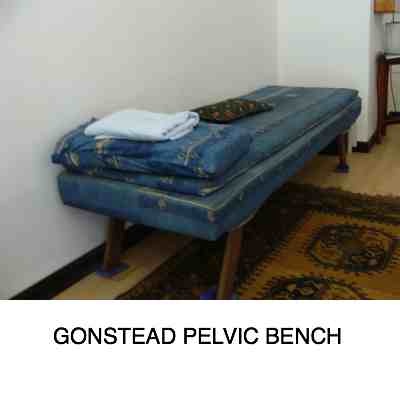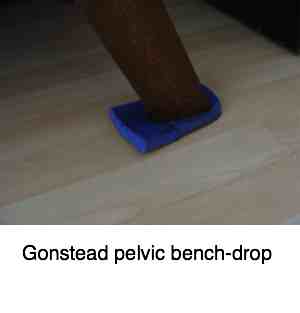Pelvic Drop Table
Innovative chiropractor Dr Clay Thompson tells how a chance discovery led him to develop the modern adjusting table. His first adjusting table after graduation was an embarrassment to him. It was old and very rickety; it creaked and groaned every time he gave a sacroiliac joint treatment.
So, once he had saved a few cents he built a new and very sturdy Chiropractic adjusting table. Being formerly an agricultural engineer he was handy at such things and obviously in retrospect an inventive man.
There was only one problem with his brand spanking new table. His patients didn't like it, they did not seem to respond as well as to Old Red and he found he had to use a lot more brute force and ignorance to adjust the lumbar spine and pelvis.
So he brought back Old Red. What was the difference? Eventually he realised that at the moment of his thrust, the adjusting bench "gave" just a little. And so the Thompson drop table came into being.

Pelvic Drop Table
PELVIC BENCH
The pelvic bench, developed apparently by Dr Clarence Gonstead is a magnificent, eminently simple sacroiliac joint adjusting table, but some chiropractors are very slow to figure things out. I'm confess I am one of them, especially as I knew about Clay Thompson and Old Red.

For a quarter of a century I've used my old faithful pelvic bench for adjusting the sacroiliac joints and lumbar spine. Then I went to the Netherlands for a stretch, published two Chiropractic books of anecdotes used two similar tables there, uncertain why one was like mine back home, the other difficult for some reason. I just could not easily get releases and soon stopped using it.
When
I returned to my native South Africa, for semi-retirement, I turned an
old garage into an adjusting room. The concrete floor didn't look that
great, my ancient Volvo 122S had an oil leak, so I spent a weekend on
hands and knees laying a wood laminate floor. Like most chiropractors I
enjoy doing physical work.


But some reason adjusting patients on "Old Blue" had changed. I
couldn't easily get
releases without resorting to more force than I am comfortable using.
For two years I wondered why and stopped using the table. The same
pelvic bench, the certainly no change in the sacroiliac joint anatomy and the same 'ole hands yet something was different.
Eventually the penny dropped, after more than two whole years, I confess. In my previous clinic, old faithful stood on a sprung wooden floor. Here, under that laminate is solid concrete. It doesn't give at all.
The solution was a derelict pair of slip slops from which the thongs had perished.
I really should have worked this out sooner as I knew that it's the principle that the great innovative chiropractor Clay Thompson used to develop the modern chiropractic adjusting table.
But anyway, all's well that ends well. Old Blue is back in vogue. Both my patients and I are happier.
Do you also need a pair of smelly old slip-slops in your clinic, doc?
Sacroiliac joint
The sacroiliac joint, particularly in the older patient, does not always lend itself to the side posture adjustment.
The patient with an arthritic hip, or who has a prosthesis is very prone to stubborn sacroiliac fixations.
In fact in my opinion, some hip replacements are accused of failing, when in fact all that needs to be done is an effective and safe sacroiliac joint adjustment.
This can be relatively easily done using the pelvic drop table, whether prone or in the side posture.
Pelvic Drop Table
The drop table principle can be used to improve a pelvic bench.
Did you find this page useful? Then perhaps forward it to a suffering friend. Better still, Tweet or Face Book it.

